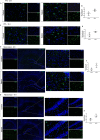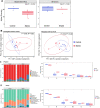A crosstalk between gut and brain in sepsis-induced cognitive decline
- PMID: 35606817
- PMCID: PMC9125851
- DOI: 10.1186/s12974-022-02472-4
A crosstalk between gut and brain in sepsis-induced cognitive decline
Abstract
Background: Sepsis is a potentially fatal disease characterized by acute organ failure that affects more than 30 million people worldwide. Inflammation is strongly associated with sepsis, and patients can experience impairments in memory, concentration, verbal fluency, and executive functioning after being discharged from the hospital. We hypothesize that sepsis disrupts the microbiota-gut-brain axis homeostasis triggering cognitive impairment. This immune activation persists during treatment, causing neurological dysfunction in sepsis survivors.
Methods: To test our hypothesis, adult Wistar rats were subjected to cecal-ligation and perforation (CLP) or sham (non-CLP) surgeries. The animals were subjected to the [11C]PBR28 positron emission tomography (PET)/computed tomography (CT) imaging at 24 h and 10 days after CLP and non-CLP surgeries. At 24 h and 10 days after surgery, we evaluated the gut microbiome, bacterial metabolites, cytokines, microglia, and astrocyte markers. Ten days after sepsis induction, the animals were subjected to the novel object recognition (NOR) and the Morris water maze (MWM) test to assess their learning and memory.
Results: Compared to the control group, the 24-h and 10-day CLP groups showed increased [11C]PBR28 uptake, glial cells count, and cytokine levels in the brain. Results show that sepsis modulates the gut villus length and crypt depth, alpha and beta microbial diversities, and fecal short-chain fatty acids (SCFAs). In addition, sepsis surviving animals showed a significant cognitive decline compared with the control group.
Conclusions: Since several pharmacological studies have failed to prevent cognitive impairment in sepsis survivors, a better understanding of the function of glial cells and gut microbiota can provide new avenues for treating sepsis patients.
Keywords: Astrocyte; Behavior; Cytokines; Inflammation; Microbiome; Microglia; PET; Sepsis; TSPO.
© 2022. The Author(s).
Conflict of interest statement
AP received preclinical research support from ACADIA Pharmaceuticals. All other authors declare that they have no competing interests.
Figures










References
-
- CDC, Data & Reports-Sepsis, C.f.D.C.a. Prevention., Editor. updated 2018.
MeSH terms
Substances
Grants and funding
LinkOut - more resources
Full Text Sources
Medical
Miscellaneous

